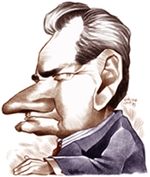
Blanche and Pickles, Amin and Milosevic - Archives Of Pain

Blanche and Pickles, Amin and Milosevic - Archives Of Pain
SLOBODAN MILOSEVIC
(born 1941), president of Serbia. While other Communist governments crumbled, a former Communist bureaucrat rose in 1989 to become Serbian head of state. He used his control of the media, government appointments, police, and the military to rouse ethnic hatred and build a Serbian nationalist mass movement.
Slobodan Milosevic was born in Pozarevac, Serbia, Yugoslavia, on Aug. 29, 1941. His schoolteacher parents were of Macedonian descent. His father left the family while "Slobo" was in grade school and left the children in the care of Slobo's mother, an active Communist.
Milosevic was a serious, reliable student who spent much of his time alone. He wrote for the school newspaper and took part in political activities. In high school he met Mirjana Markovic, daughter of a leading Serbian Communist family. They later married and had two children, Marija and Marko.
Milosevic completed his law degree at the University of Belgrade in 1964. An older law student, Ivan Stambolic, became his friend and mentor. As a loyal Communist, Milosevic benefited from Marshal Tito's ouster of reformers from government-controlled positions in the 1970s. He was appointed manager of an energy plant and then president of a large Belgrade bank. His career continued to prosper after Tito died in 1980.
In 1984 Stambolic, recently made Serbian Communist party leader, appointed Milosevic head of the Belgrade party committee. Belgrade was a center for liberal reformers and Serbian nationalists, but Milosevic firmly suppressed the dissidents. He censored publications and promoted Marxism in the schools. In January 1986 Stambolic advanced to president of Serbia and Milosevic replaced him as Serbian party chief.
Stimulated by the plight of the Serb minority in Kosovo, an autonomous province of Serbia controlled by ethnic Albanians, Milosevic abandoned the traditional Communist conviction that the party should transcend nationalist beliefs. In a break with Tito's legacy, he used newspapers and television to stir up ethnic feeling among the Serbs. Nationwide television broadcast a debate at the Sept. 23, 1987, party meeting during which leading Communists severely criticized Stambolic's regime for its failure to defend Serbian interests in Kosovo. Two months later Stambolic resigned.
Having orchestrated his former friend's downfall, Milosevic ran Serbian politics from behind the scenes and built a base of support in the army. In 1989 he published a book of speeches and interviews. On May 8 of that year, the parliament elected him president of Serbia. In July 1990, seeing Communism on the wane, he renamed his party the Socialist Party of Serbia. That December, Serbia held its first contested elections. Favored by the government-controlled media, Milosevic won. Demonstrations against him broke out in March 1991.
By that time other Yugoslav republics were moving toward independence. Slovenia and Croatia declared their independence from Yugoslavia on June 25, 1991, as did Bosnia ten months later. Many in Serbia worried about the safety of the Serb minorities in Croatia and Bosnia. Instead of trying to negotiate a solution, Milosevic encouraged the Yugoslav army to attack Croatia and the Bosnian Serbs to seize land by force. In the civil wars that followed, he armed the Serbs in Croatia and Bosnia and roused ethnic hatred at home. Tens of thousands died in the ensuing civil war. Western nations recognized the breakaway republics and imposed sanctions on Serbia. Milosevic, however, easily won reelection as Serbian president in December 1992.
The war, lack of economic reform, and the Milosevic family's accumulation of money and power alienated students and intellectuals. Discontent spread to workers hurt by unemployment and plummeting wages. After Milosevic annulled opposition victories in local elections in November 1996, tens of thousands of protesters marched in the streets of Belgrade daily for months.